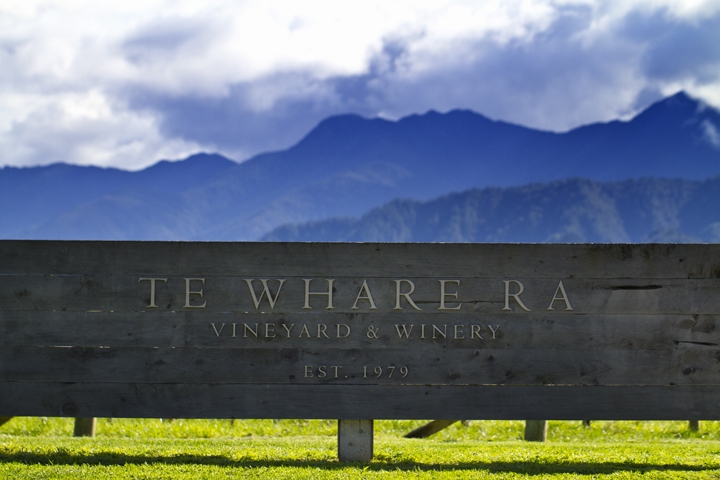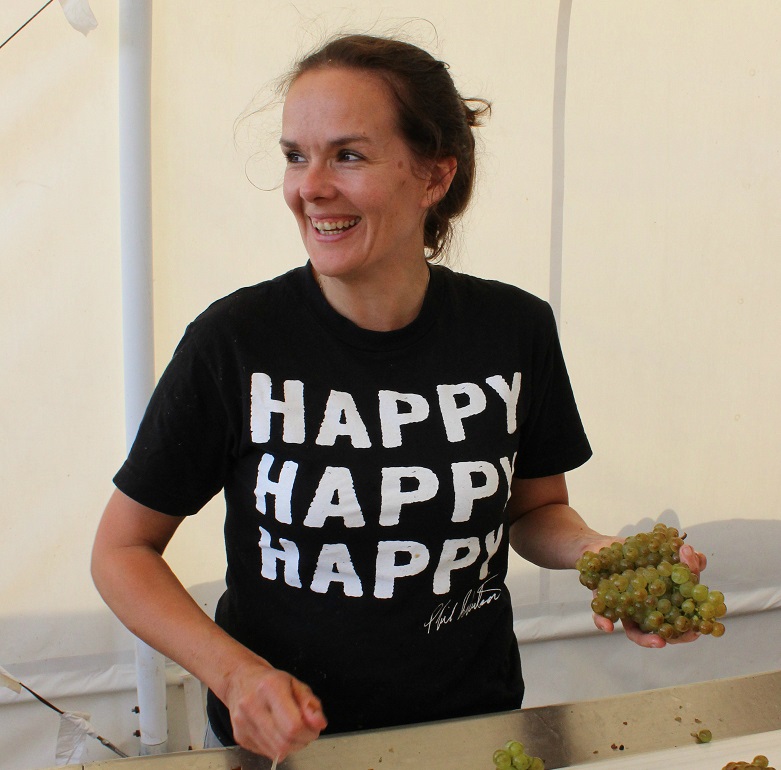by Ed Merrison

Anna Flowerday says ‘cool’ a lot. Not ‘cool’ as in climate – though her journey from fifth-generation Shiraz-swilling McLaren Vale lass to South Island NZ is a big part of the story. Nor ‘cool’ meaning on-trend – in fact some of the best moves she’s made run counter to fashion (and received wisdom). No, just cool in that simple, spontaneous way that says you’re going to dig it, whatever happens.
Example: it’s “pretty cool” that’s she gets to do a job she utterly loves with her husband. The fact that Marlborough Pinot is underrated isn’t an injustice; it’s a “cool opportunity”. And it’s “a cool thing” that her two sets of twin girls get to see her excel in a role once seen as the domain of men. “I’m very conscious of being a mother of four daughters and I want them to think they can do anything,” she says.
This positivity shimmers through Anna’s perspective on Marlborough, where she and husband Jason have been running the Te Whare Ra (TWR) winery for the past decade. When we catch up over coffee in Melbourne, I ask whether the region’s runaway success with Sauvignon Blanc has been a blessing or a curse. She concedes it’s a double-edged sword, with “savvy” stealing the limelight – and the vineyard area – from other varieties, and leading some to write off Marlborough as a one-trick pony.
But she also sees the grape, which accounts for a third of TWR production, as a wellspring of opportunity. “To me Marlborough and Sauvignon was just a lucky accident, a variety and place that gave you something a bit different and a bit special,” she says. “I think it’s introduced people to Marlborough and it’s up to us as winemakers to be a bit thoughtful about what we do with it. At Te Whare Ra we’re trying to make a long-term, really strong estate. I want to be known for a really cool range of wines and it’s kind of like my kids; I like them all for different reasons on different days, but I love them all equally.”

It’d be tempting to put her sunny outlook down to all that UV light but in fact the unbridled optimism goes back to where it all started: Hardys in McLaren Vale in the mid-1990s. For a young winemaker back then, it was the coolest gig in town. “Wine was king, and there were a lot of us who were all pretty young. We all knew we’d been given a massive opportunity and we worked our arses off to prove ourselves.”
She was at Hardys for seven years all up, working in a positive, collaborative culture that encouraged speaking up and trying things out. “If you look at the Hardys kindergarten and who’s come out of it – Stephen Pannell and KT (Kerri Thompson) were slightly older than me and then there was Larry Cherubino, Rob Mann, Sue Bell – a lot of young winemakers who are now in the upper echelon in Australia. Those really were the glory days,” she says.
Much of the credit goes to Peter Dawson, Hardys chief winemaker of the time and now co-owner of Dawson & James in Tasmania. “The two things he believed in were passion and palate,” says Anna. “Those are the two things he looked for in winemakers and I think they stand you in good stead. No matter where you are or what you’re doing, that’s really what this industry’s all about.”
At Hardys Anna also fell deeply in love – twice. The first time was in McLaren Vale and took the form of “that old vintage romance kind of thing” with Marlborough boy, Jason Flowerday. And the other – no less significant – was when she was promoted to a position at Leasingham in Clare Valley, working with Kerri Thompson. “That’s really where the love of Riesling kicked in and I guess that just spread to other aromatic varieties.”
The Flowerdays’ aromatic white range now takes in Riesling, Pinot Gris and Gewürztraminer, as well as a blend of all three, named Toru. Their success in this area has a lot to do with organic and biodynamic viticulture, says Anna. The vines are routinely delivering sugar, acid and flavour ripeness at the same time, so there’s no need to go chasing balance in the winery. “With Riesling you’re balancing the sweetness and the acidity; with Pinot Gris there’s a bit of that but then texture comes into it too; Gewürz has no acidity so you’re almost balancing the alcohol and the ripeness of the wine again with the sweetness. But when you get it right, it’s almost like you don’t see it. Balance really equals drinkability.”
As well as opening up aromatic options, life in a cool climate has changed Anna’s tastes. Where once she’d think nothing of knocking back youthful, ball-busting Shiraz, these days those same wines face a 10-year wait in the cellar, while whites and Pinot Noir are constant companions. “I guess one thing that I really look for – and I’ve appreciated it a lot more as I’ve matured as a winemaker – is that there’s a lot of beauty in purity. I think especially coming out of those late 90s, everything was about ‘big’ – big this, big that, big oak, big fruit – and I look now for more subtlety and nuances. I’m happy with wines that are a bit quieter, more understated.”
 True to form, she loves the challenge of the heartbreak grape. When they bought the vineyard in 2003, the Pinot Noir vines were young and not ready to deliver the wine they wanted – a fact that no amount of winery wizardry could distort. “Pinot’s about patience, that’s one thing I really have learned. You can’t force it anywhere it doesn’t want to go. If you overwork it or you cut corners you’re really going to see that in the wine. It’s very transparent like that. It’s both a challenge and an opportunity.”
True to form, she loves the challenge of the heartbreak grape. When they bought the vineyard in 2003, the Pinot Noir vines were young and not ready to deliver the wine they wanted – a fact that no amount of winery wizardry could distort. “Pinot’s about patience, that’s one thing I really have learned. You can’t force it anywhere it doesn’t want to go. If you overwork it or you cut corners you’re really going to see that in the wine. It’s very transparent like that. It’s both a challenge and an opportunity.”
Now, with older vines and better farming practices, the complexity has come of its own accord and TWR’s Pinot has won ardent fans. Thanks to greater care and investment across the region – and the annual Pinot Bootcamp where winemakers gather to compare notes on trial wines – Anna views Marlborough as the sleeping giant of Kiwi Pinot. “There’s a really strong line-up that I’d happily stand by and defend to all comers,” she says.
But if Marlborough Pinot has long “been the bridesmaid” Syrah would be lucky to even crack an invite. “It was a bit of a punt, to be honest,” Anna admits. It’s one that has paid off – but how did they come to take the plunge in the first place? Turns out the Hardys have-a-go spirit is only part of the answer. Temperature data monitoring and ripening dates had alerted them to a warm spot in the vineyard that might show promise. On top of that, TWR’s founders used to have a block they used for a Bordeaux blend, and a look at some of the old vintages showed they’d managed to ripen Cabernet almost as often as not. So from there Syrah – which tends to ripen a month or so earlier – was in with a chance. “If you asked 10 people in the region, nine of them would say you’re totally nuts to even try it. But that’s the whole point of what we’re doing. It’s not same-same and we don’t have to wear a commercial hat all the time.”
 Picking the Syrah together is a Flowerday family tradition. The two sets of twins, who’ve just turned seven and ten respectively, really enjoy it – and it’s more than a clever cost-cutting exercise for their parents. “I think it’s good for them to understand what we do and why we do it,” says Anna. “Wine is such an obsessive thing. It’s our life, not just a job. And I think if you’re not into it, it’s actually quite hard to understand why you’re there for all those hours or why it’s a 360-day-a-year thing.”
Picking the Syrah together is a Flowerday family tradition. The two sets of twins, who’ve just turned seven and ten respectively, really enjoy it – and it’s more than a clever cost-cutting exercise for their parents. “I think it’s good for them to understand what we do and why we do it,” says Anna. “Wine is such an obsessive thing. It’s our life, not just a job. And I think if you’re not into it, it’s actually quite hard to understand why you’re there for all those hours or why it’s a 360-day-a-year thing.”
And if you find your TWR wine seamlessly drinkable, then that might just be the taste of marital harmony. Anna says she and Jason make better wines together than they ever did in their individual careers. “Some of the best wines I’ve ever had were made by more than one person, because you’re not infallible and different people are sensitive to different things.” Anna and Jason “agree 95% of the time” – with the vexed question of when to pick being the source of most of their domestics.
And she credits Jason with what she sees as their proudest achievement at TWR: the restoration of some of the oldest vines in Marlborough to impeccable health. When they purchased the property they were “pretty near stuffed”, to the point where many would’ve given up on them. But instead those same vines live on to lend their own character to the wines. “And that’s really full credit to Jase because he’s the guru of growing things. He just has a real knack for understanding plants and what they need, and I get the benefit of that when we bring the fruit into the winery.”
Theirs is a vineyard that gets checked out an awful lot, such is the paperwork that goes with organic and biodynamic certification. But do you want to know the coolest thing? It’s when those soil scientists come with their clipboards and declare TWR the best organic vineyard in New Zealand. “Because everything we do is about being the best,” says Anna. “Not the biggest, not the loudest. It’s a long game that we’re playing, and I think we’re taking Te Whare Ra to a good place.”